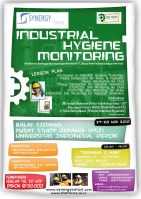SAFETY PROMOTION & COMMUNICATION
(Attention: the video above is not for distribution and not for commercial. It’s social education purpose only)
What do you feel to the video play? Do you feel so close and melt perfectly to the each scene of the video? The video is in diversity student work together for lecture project in University of Indonesia way to promote safety and health culture in 2005. The author is going to give an expository writing concern to safety promotion and communication.
Promotion and communication has close relation to develop the aim of safety and health culture. The prime objective of safety promotion and communication is to promote health and safety at the workplace and is to foster a culture whereby health and safety becomes an automatic response by all persons at all times.
We will resume the communication first.. Communication is defined the transfer of information and interpretation from a person to other person (Davis, 1981). Communication consists of sender, receiver, information, feedback, adjustment. While communication can be verbal or nonverbal, most of our communication is verbal which is influenced by vocabulary, racing, voice intonation, humorous, concise, distinct and timing.
The indicator effective communication:
- The intent of the sender of a message
- The background and prejudices of the sender
- The means of transmission
- The unexpressed feelings of the receiver
- The background prejudices of the receiver that cause him to interpret the message the way he does
According the indicator above, “Communication is the meaning attached to any experience a person has”
Safety promotion program is applied through communication way and aimed to positive company, organization or country performance.
A company wishing to improve its performance will need to judge its existing practices against a number of features essential to a sound safety culture, namely: ‘ownership’ of health and safety must permeate at all levels of the work force; this involves employee involvement, training and communication.
The main principles involved, which involve the establishment of a safety culture, accepted and observed generally, are: promotion and reward of enthusiasm and good results.
(Jeremy Stranks, 2006)
According to ISO 9001: 2000 Quality management systems – requirements is pointed that top management shall ensure that appropriate communication processes are established within the organization and that communication takes place regarding the effectiveness of the quality management system.
Communication and promotion have making deal to build safety and health culture. International Labor Conference (ILO) has defined in promoting a national preventative safety and health culture to should seek:
(a) to raise workplace and public awareness on occupational safety and health through national campaigns linked with, where appropriate, international initiatives;
(b) to promote mechanisms for delivery of occupational safety and health education and training, in particular for management, supervisors, workers and their representatives and government officials responsible for safety and health;
(c) to introduce occupational safety and health concepts in educational and vocational training programmes;
(d) to facilitate the exchange of occupational safety and health statistics and data between relevant authorities, employers, workers and their representatives;
(e) to provide information and advice to employers and workers and their respective organizations and to promote or facilitate cooperation among them with a view to eliminating or minimizing work-related hazards and risks;
(f) to promote, at the level of the workplace, the establishment of safety and health policies and joint safety and health committees and the designation of workers’ safety representatives, in accordance with national law and practice; and
(g) to address the constraints of micro-enterprises and small and medium-sized enterprises and contractors in the implementation of occupational safety and health policies and regulations, in accordance with national law and practice.
(red: franciskus hutasoit)
References:
- Stranks, Jeremy. 2006. Health and Safety Pocket Book – First edition. UK: Elsevier Ltd.
- ILO. 2006. Report IV (2B) Promotional framework for occupational safety and health 95th Session. Geneva, Switzerland: International Labour Conference
- Robbins P., Stephen. 1996. Perilaku Organisasi – Jilid 2 edisi bahasa indonesia. New Jersey: Prentice Hall
- Council of Standards Australia. 2000. Quality management systems – Requirements. New Zealand Standard: AS/NZS ISO





















Pingback: Health & Safety Leadership Supervisory (H&SLS) | SHE FOCUS
Pingback: PERMIT TO WORK (PTW) ATAU LEGALITAS UNTUK BEKERJA (LUB) | SHE FOCUS
Pingback: INTRODUCTION HAND TOOLS SAFETY | SHE FOCUS